
Java JAX-RS is a powerful framework that can simplify code and improve development efficiency through annotations. PHP editor Xinyi will help you uncover the charm of these annotations, explore their potential in depth, and help you better understand and apply this technology. As you read the article, you will learn how to use annotations to implement more flexible RESTful services and improve code readability and maintainability. Let’s explore the secrets of Java JAX-RS annotations!
Java api for RESTful WEB Services (JAX-RS) is a Java specification that provides a flexible and powerful framework for building RESTful Web services. . JAX-RS annotations play a vital role as they simplify API development, improve readability and maintainability, and eliminate redundant code. This article will delve into the power of JAX-RS annotations and demonstrate their advantages in practical applications through demonstration code.
@Path and @GET: Defining REST endpoints
The@Path annotation is used to define the path to the REST endpoint. For example:
@Path("/api/customers")
public class CustomerResource {
@GET
public Response getCustomers() {
// 业务逻辑
}
}
The above code defines a REST endpoint /api/customers for obtaining all customer information. The @GET annotation specifies that the endpoint uses the Http GET method.
@PathParam and @QueryParam: Handling path and query parameters
@PathParam annotation is used to handle path parameters, while @QueryParam annotation is used to handle query parameters. For example:
@Path("/api/customers/{id}")
public class CustomerResource {
@GET
public Response getCustomer(@PathParam("id") Long id) {
// 业务逻辑
}
}
The above code defines a REST endpoint /api/customers/{id}, which accepts an id path parameter. Likewise, the @QueryParam annotation can be used to handle query parameters, for example:
@Path("/api/customers")
public class CustomerResource {
@GET
public Response getCustomers(@QueryParam("name") String name) {
// 业务逻辑
}
}
@Produces and @Consumes: Specify request and response format
The@Produces annotation specifies the MIME types used by the web service when generating responses, while the @Consumes annotation specifies the MIME types supported by the web service when receiving requests. For example:
@Path("/api/customers")
public class CustomerResource {
@GET
@Produces(MediaType.APPLICATioN_JSON)
public Response getCustomers() {
// 业务逻辑
}
}
The code above specifies that the endpoint generates responses in jsON format.
@POST and @RequestBody: Handling POST requests
The @POST annotation is used to define the endpoint that handles POST requests, while the @RequestBody annotation is used to handle the request. For example:
@Path("/api/customers")
public class CustomerResource {
@POST
@Consumes(MediaType.APPLICATION_JSON)
public Response createCustomer(@RequestBody CustomerDTO customer) {
// 业务逻辑
}
}
The above code defines a REST endpoint for receiving customer information in JSON format and creating new customers.
@ResponseStatus: Specify HTTP response status
The@ResponseStatus annotation is used to specify the HTTP response status code. For example:
@Path("/api/customers/{id}")
public class CustomerResource {
@DELETE
@ResponseStatus(httpstatus.NO_CONTENT)
public void deleteCustomer(@PathParam("id") Long id) {
// 业务逻辑
}
}
The above code specifies that after the customer deletion operation is successful, an HTTP 204 No Content status code will be returned.
in conclusion
JAX-RS annotations provide JAVA WEB service developers with a powerful and flexible mechanism that simplifies API definition, improves readability and maintainability, and eliminates redundant code. By understanding and effectively utilizing these annotations, developers can create efficient, robust, and scalable RESTful web services.
The above is the detailed content of The beauty of annotations in Java JAX-RS: Uncovering their potential. For more information, please follow other related articles on the PHP Chinese website!
 PHP 代码文档化之王:PHPDoc 的进阶指南Mar 02, 2024 am 08:43 AM
PHP 代码文档化之王:PHPDoc 的进阶指南Mar 02, 2024 am 08:43 AM引言:PHPDoc是一种用于php代码的注释标准,可生成易于理解且信息丰富的文档。通过使用特定的注释标签,PHPDoc允许开发人员提供有关函数、类、方法和其他代码元素的重要详细信息。这篇进阶指南将深入探讨PHPDoc,展示其功能并提供有效的文档化策略。语法和标签:PHPDoc注释以双斜杠(//)或多行注释(/**/)开头。以下是一些常见的注释标签:@param:定义函数或方法的参数。@return:指定函数或方法的返回值。@throws:说明函数或方法可能引发的异常。@var:定义类的属性或实例
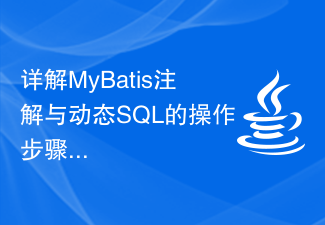 详解MyBatis注解与动态SQL的操作步骤Feb 18, 2024 pm 03:29 PM
详解MyBatis注解与动态SQL的操作步骤Feb 18, 2024 pm 03:29 PMMyBatis注解动态SQL的使用方法详解IntroductiontotheusageofMyBatisannotationdynamicSQLMyBatis是一个持久层框架,为我们提供了便捷的持久化操作。在实际开发中,通常需要根据业务需求来动态生成SQL语句,以实现灵活的数据操作。MyBatis注解动态SQL正是为了满足这一需求而设计的,本
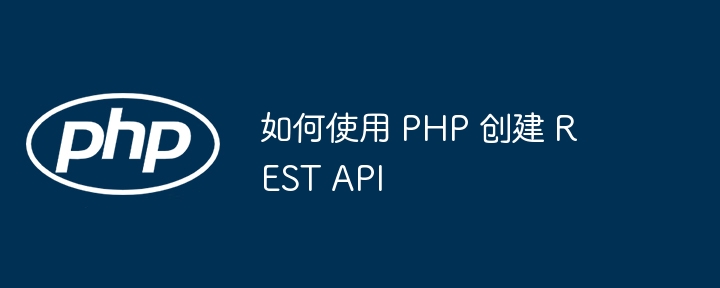 如何使用 PHP 创建 REST APIMay 01, 2024 pm 09:09 PM
如何使用 PHP 创建 REST APIMay 01, 2024 pm 09:09 PM使用PHP创建RESTAPI涉及以下步骤:安装PHP和RESTfulAPI框架。创建API路由以处理HTTP请求。定义控制器及其方法来处理路由请求。格式化API响应,包括状态代码和JSON数据。通过实战案例了解如何使用PHP和Laravel创建RESTAPI。
 PHP REST API的测试与调试方法May 31, 2024 am 10:50 AM
PHP REST API的测试与调试方法May 31, 2024 am 10:50 AMPHPRESTAPI测试与调试方法:单元测试:隔离代码模块并验证输出。集成测试:测试API组件协作。端到端测试:模拟完整用户流程。调试工具:日志记录、调试器和API测试工具。断言验证:在测试中使用断言检查预期结果。
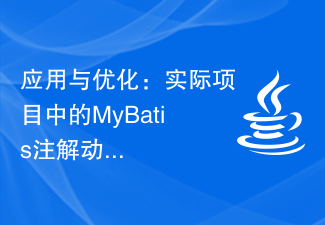 应用与优化:实际项目中的MyBatis注解动态SQLFeb 19, 2024 am 09:55 AM
应用与优化:实际项目中的MyBatis注解动态SQLFeb 19, 2024 am 09:55 AMMyBatis注解动态SQL在实际项目中的应用与优化引言:MyBatis是一款优秀的持久层框架,它提供了多种SQL映射的方式,包括XML配置文件和注解。其中注解动态SQL是MyBatis的一项强大的功能,可以在运行时根据条件动态生成SQL语句,适用于处理复杂的业务逻辑。本文将介绍MyBatis注解动态SQL在实际项目中的应用,同时分享一些优化技巧与代码示例。
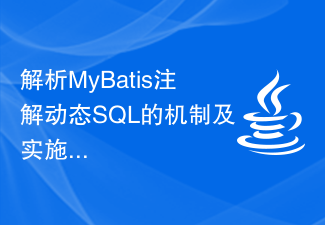 解析MyBatis注解动态SQL的机制及实施Feb 20, 2024 pm 12:57 PM
解析MyBatis注解动态SQL的机制及实施Feb 20, 2024 pm 12:57 PM深入理解MyBatis注解动态SQL的原理与实现MyBatis是一个流行的Java持久化框架,它提供了一种方便的方式来处理数据库操作,同时也支持动态SQL。动态SQL是指根据不同的条件,在运行时动态地生成不同的SQL语句。MyBatis提供了两种实现动态SQL的方式,分别是XML配置方式和注解方式。本文将深入解析MyBatis注
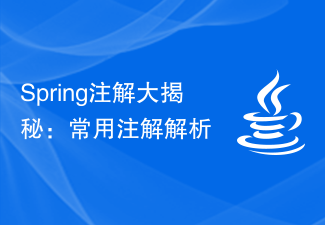 Spring注解大揭秘:常用注解解析Dec 30, 2023 am 11:28 AM
Spring注解大揭秘:常用注解解析Dec 30, 2023 am 11:28 AMSpring是一个开源框架,提供了许多注解来简化和增强Java开发。本文将详细解释常用的Spring注解,并提供具体的代码示例。@Autowired:自动装配@Autowired注解可以用于自动装配Spring容器中的Bean。当我们在需要依赖的地方使用@Autowired注解时,Spring将会在容器中查找匹配的Bean并自动注入。示例代码如下:@Auto
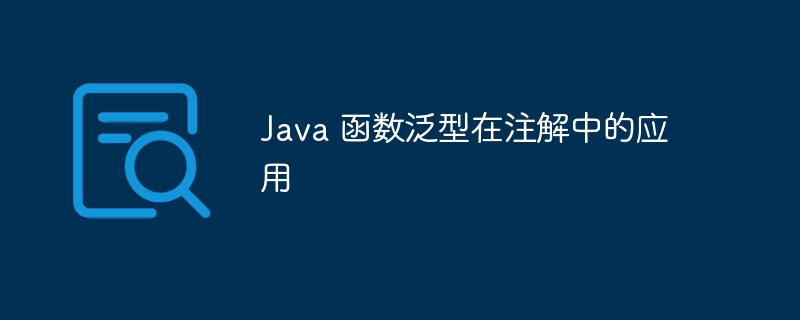 Java 函数泛型在注解中的应用Apr 25, 2024 pm 02:33 PM
Java 函数泛型在注解中的应用Apr 25, 2024 pm 02:33 PMJava函数泛型可应用于注解中,提供更高的灵活性。其语法为@interfaceAnnotation<T>{Class<T>containerClass();},其中T为泛型类型参数,containerClass()方法返回保存泛型类型的Class对象。通过该注解,我们可以验证方法参数类型,提高注解的可重用性和灵活性。


Hot AI Tools

Undresser.AI Undress
AI-powered app for creating realistic nude photos

AI Clothes Remover
Online AI tool for removing clothes from photos.

Undress AI Tool
Undress images for free

Clothoff.io
AI clothes remover

AI Hentai Generator
Generate AI Hentai for free.

Hot Article

Hot Tools

Dreamweaver Mac version
Visual web development tools

SublimeText3 Chinese version
Chinese version, very easy to use

SAP NetWeaver Server Adapter for Eclipse
Integrate Eclipse with SAP NetWeaver application server.

Safe Exam Browser
Safe Exam Browser is a secure browser environment for taking online exams securely. This software turns any computer into a secure workstation. It controls access to any utility and prevents students from using unauthorized resources.

VSCode Windows 64-bit Download
A free and powerful IDE editor launched by Microsoft






